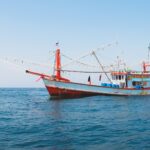Our oceans are in crisis, and endangered aquatic animals are paying the price. From the illegal seafood trade to habitat loss from climate change, many marine species are threatened with extinction. They play critical roles in maintaining our aquatic ecosystems and sustaining our global seafood supply, with severe consequences beyond our oceans if they go extinct.
Learn more about the causes of endangered ocean life, the top threatened species, and what we can do to safeguard them from extinction.
The Most Endangered Aquatic Animals & Mammals: The Causes & Their Critical Importance in Our Marine Ecosystems
Below is a breakdown of the top endangered marine species, the leading threats to extinction, and why they’re critical to our oceans.
Understanding the Top 5 Most Endangered Aquatic Animals
1. Hawksbill Turtle

The Hawksbill Turtle is currently classified as critically endangered, meaning it faces the highest risk of extinction. Also known as Hawksbills, they’re an aquatic reptilian species that live in several global tropical and subtropical oceanic habitats: the Mesoamerican Reef, the Southwest Indian Ocean, the Southwest Pacific Ocean, and Indonesia.
Several threats contribute to the decline of Hawksbills, including:
- Illegal Wildlife Trade: The biggest threat to this species, even with multiple international protection laws, is their sought-after meat for food in many countries (even though their meat can be toxic to humans from the sponges they eat) and shells to manufacture black market jewelry and ornaments.
- Fishery Bycatch: Hawksbills are highly susceptible to gillnet entanglement and accidental fishing hook captures from fisheries, causing them to drown.
- Nesting and Feeding Habitat Loss: Pollution, coastal development, and ocean acidification have harmed the natural habitats where Hawksbills nest, feed, and migrate.
- Excessive Egg Collection: The overharvesting of Hawksbill eggs to sell for consumption remains a major threat.
Because Hawksbills live primarily in coral reefs and feed on sponges, sea anemones, and jellyfish, they’ve played a fundamental role in our marine ecosystems since their existence on our planet for the last 100 million years. They maintain the health of coral reefs and seagrass beds, providing better access for reef fish species to feed.
2. Sea Turtle
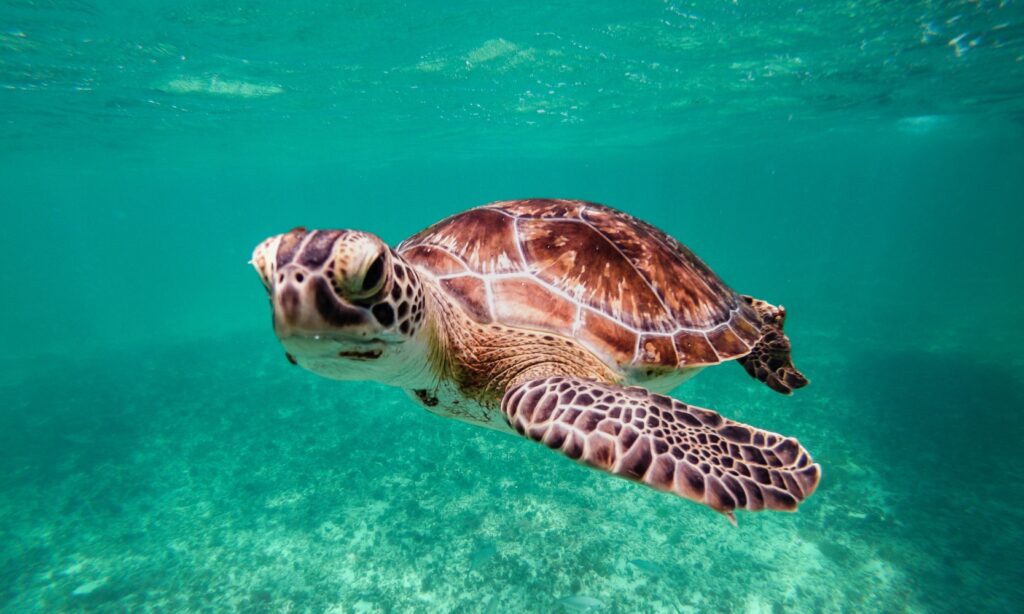
Sea Turtles are classified as endangered and critically endangered for certain species, putting them at severe risk of extinction, with over 10,000 lost annually. There are seven types of sea turtle species (including Hawksbills) with multiple open water and coastal habitats, such as the Indian Ocean, the Coral Triangle coral reefs, and the Eastern Pacific beaches.
The leading threats to Sea Turtles include:
- Illegal Poaching & Exploitation: They are illegally slaughtered for their eggs, meat, skin, and shells.
- Habitat Destruction: Climate change has negatively altered sand temperatures where they nest and impacts the sex of hatchlings.
- Bycatch: Accidental captures in commercial fishery nets and gear
As mentioned above, Sea Turtles are critical to maintaining the health of our coral reefs and seagrass. Species that live in these habitats, such as shrimp and lobsters, have high commercial value and rely on them for survival. Sea Turtles also have cultural significance in coastal cultures and have high tourism value, like hatchling releases and snorkeling tours.
3. Whale Shark

The Whale Shark is the largest shark and fish species in the world and is currently classified as endangered. Records show they can grow up to 60 feet and weigh around 11 tons, but the maximum size isn’t known. They live in tropical oceans across the globe: the Mesoamerican Reef, the Southwest Indian Ocean, the Southwest Pacific Ocean, and Indonesia.
There are three main causes for the decline of Whale Sharks:
- Unregulated International Fisheries: The high value of their meat, fins, and oil remains an imminent threat in international markets, specifically from unregulated fisheries.
- Bycatch: Accidental captures from commercial fisheries as they target species that Whale Sharks eat.
- Marine Tourism: Oceanic tourism activities disrupt their feeding and cause injuries from boat propellers.
Whale Sharks feed on bottom feeders like small fish and plankton and migrate long distances, typically alone, to sustain their large size and reproduce. Although they gather in groups when feeding, Whale Sharks control plankton populations to prevent imbalances that harm larger fish species, distribute essential nutrients from their waste during migration, and maintain the critical health of our marine ecosystems.
4. Bluefin Tuna
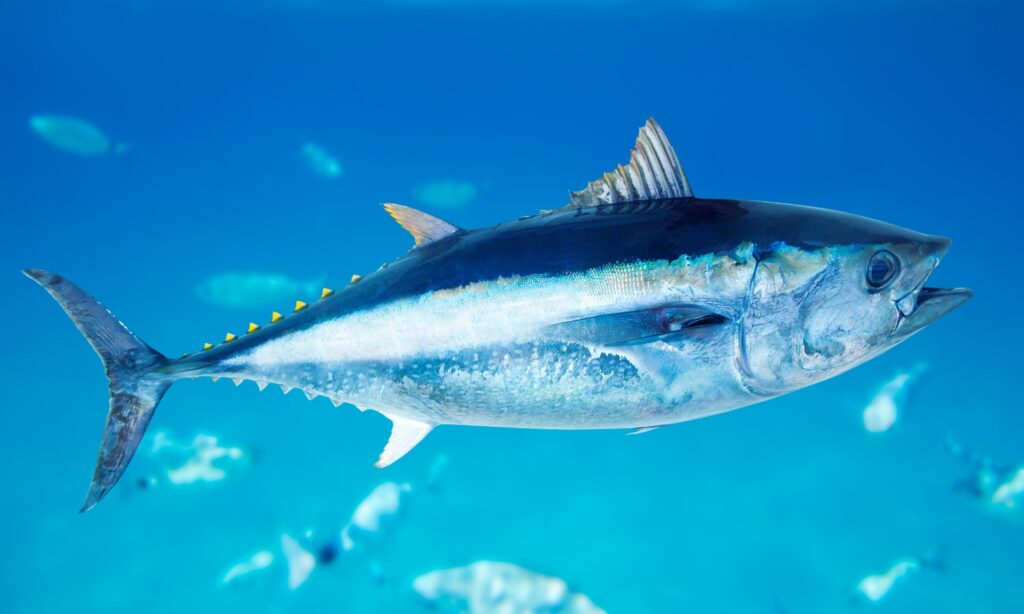
The Bluefin Tuna is the largest tuna species in the world and is classified as endangered. They can grow up to 10 feet long and weigh up to 1,500 pounds. There are three types of Bluefin Tuna species: Atlantic (largest and most endangered), Pacific, and Southern. Depending on the species, they live in the Southwest Pacific Ocean and Indonesia.
Pirate fishing and overfishing are the top threats to the extinction of the Bluefin Tuna. As a commercially valuable delicacy species in high-demand sushi and sashimi markets, illegal fishing locations and exploitative overfishing have contributed to their rapid decline.
Bluefin Tuna are a top predator that maintains the necessary balance in marine environments by feeding on smaller fish prey. They also distribute nutrients from deep waters to the surface, supporting the health of other oceanic species. Additionally, Bluefin Tuna are among the most valuable commodities in the commercial seafood market, holding economic importance.
5. Galápagos Penguin
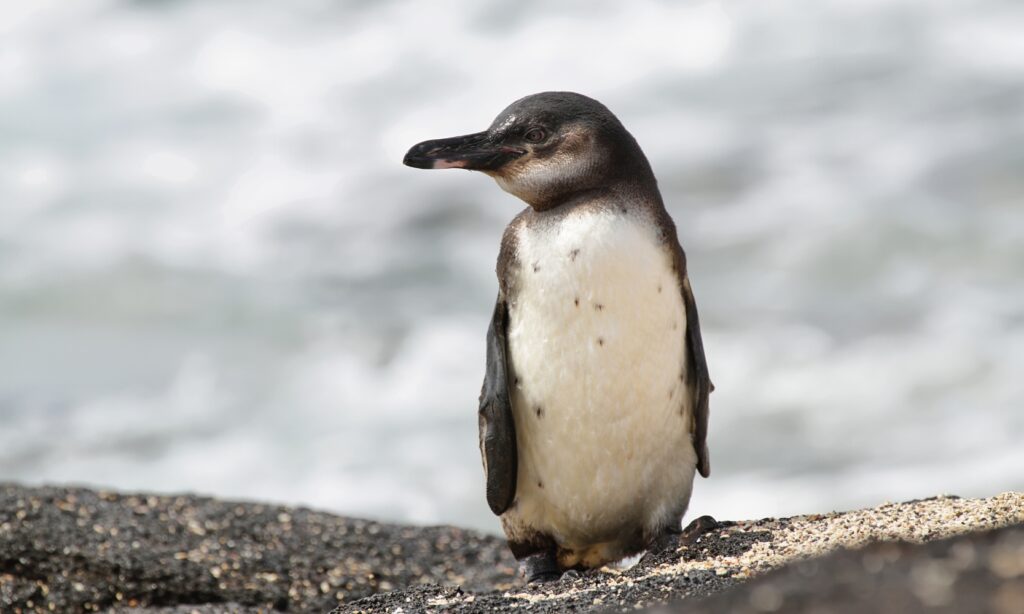
The Galápagos Penguin is the only penguin species north of the equator and in the Galápagos. They’re classified as endangered, with a population of fewer than 2,000 left.
The leading causes of the extinction of the Galápagos Penguin are pollution, bycatch, and climate change—especially from strong El Niño seasons, causing up to 77% of mortalities and reduced breeding rates. However, domestic species, like dogs, spread disease, and cats that prey on them are also a threat.
Galápagos Penguins play a critical role in the island’s food chain, feeding on small fish and crustaceans to maintain their population control. They’re also prey for larger predators like sharks and sea lions. Additionally, Galápagos Penguin waste is a natural fertilizer to enrich coastal soils and native aquatic plants and cycle necessary nutrients from the ocean to land.
Understanding the Top 5 Most Endangered Marine Mammals
1. Vaquita
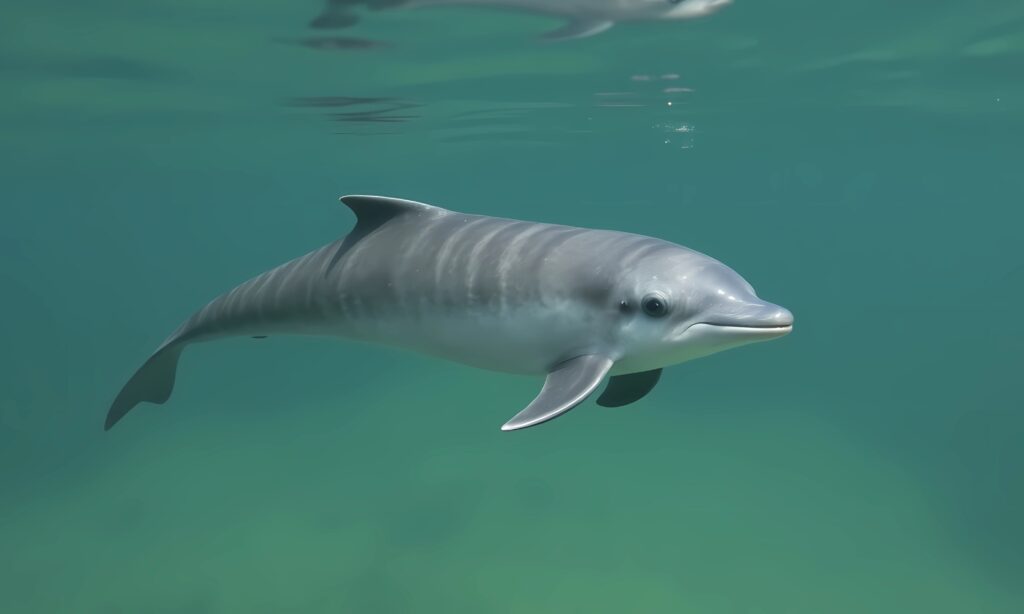
Vaquitas are arguably the most endangered marine mammals, as they’re classified as critically endangered, with about 10 left in the current population–making them on the brink of extinction. They’re recognized as the world’s rarest marine mammal, as the smallest porpoise species, and live in the shallow waters of the northern Gulf of California.
According to the World Wildlife Foundation (WWF), one out of every five Vaquitas gets entangled and drowns in fishery gillnets intended for Totoaba (a critically endangered fish species), which is the primary threat to their rapid decline. Although international trade of Totoabe is banned, illegal fishing remains due to the high demand and reward for catching them due to their swim bladders in Chinese medicine.
Vaquitas play a critical dual predator and prey role in the natural marine food chain. They feed on fish, squid, and crustaceans that regulate their populations and are consumed by larger predators like sharks and killer whales.
2. Sea Lion
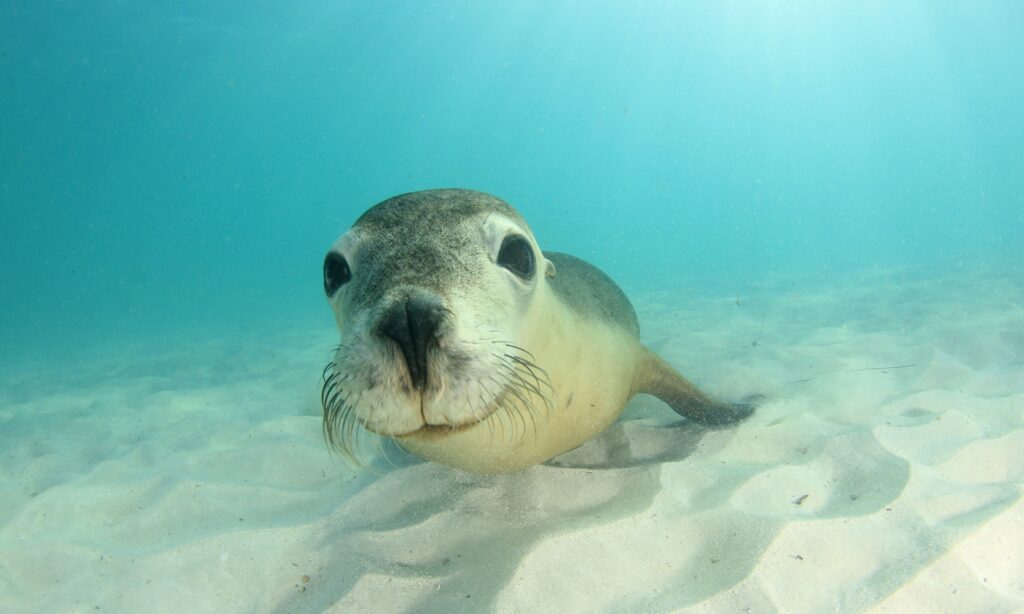
There are various species of Sea Lions with global land and sea habitats, including New Zealand, the Galápagos Sea, and the southern Australian coast.
However, they’re classified as endangered for the following reasons:
- Fishing Boat Barriers & Bycatch: Sea Lions stay together in large colonies and often rest on fishing boats, causing them to sink. As a result, fishermen install barbed wire to protect their boats, but it causes severe injuries to them. They’re also victims of bycatch.
- Introduced Domestic Species: Dogs commonly carry diseases that spread to Sea Lions.
- Climate Change: The negative effects of climate change reduce the prey species they feed on.
Sea Lions are both prey and predators within the marine food chain, making it crucial to conserve this species for the optimal balance of our aquatic ecosystem. They mainly feed on squid and herring, and are consumed by Great White Sharks, Orcas, and other large predatory species.
Sea Lions are also an indicator of island ecosystem health because their waste is studied for climate-change-related ecosystem shifts and transports nutrients from the ocean to land that fertilize the soil they rest on.
3. North Atlantic Right Whale

The North Atlantic Right Whale is classified as endangered and among the most endangered large whale species. The WWF claims that some scientists believe they’re extinct in the eastern North Atlantic and only survive along the eastern coasts of the U.S. and Canada.
Several threats contribute to their population decline, including:
- Whaling Industry Exploitation: Since they float after death, whaling rates have intensified, making it easier to hunt them for their sought-after oil, blubber, and other cetacean products—causing their population to rapidly decline to about 500.
- Climate Change: Increasing ocean temperatures impact their food sources, like tiny plants and animals that move or can’t survive.
- Shipping Traffic: Boat collision and bycatch create major threats, and high shipping traffic separates them from their calving areas. Studies also suggest that ships create chronic noise that hinders their ability to communicate with each other, find food, mate, migrate, and avoid predators.
Since North Atlantic Right Whales have a slow-growing population, these threats have significant negative impacts on their existence. They’re known as “marine ecosystem engineers,” as they redistribute nutrients from the ocean bottom to the surface through their waste. These essential nutrients fertilize the water and support phytoplankton and tiny aquatic plant species growth they feed on in the ocean’s food web.
4. Blue Whale

The Blue Whale is the largest and loudest animal on the planet and is classified as endangered, with an estimated population between 10,000 and 25,000 left. They weigh almost 200 tons, can grow up to 100 feet long, and project their frequency whistles up to 188 decibels–louder than a jet engine. They live in oceanic habitats of Southern Chile, the Southwest Pacific Ocean, and Indonesia.
Blue Whales face multiple threats, including habitat loss, toxins, and lower krill availability they feed on from climate-related change, ship collision harm, and bycatch.
As apex predators, they’re at the top of the food chain and play a leading role in maintaining the balance of our oceans’ ecosystems. Since they massively consume up to six tons of krill daily, they control their population to prevent imbalance in the marine food web.
They also act as “carbon sinks,” absorbing and storing carbon dioxide in their bodies to cycle nutrients between the surface and deep ocean, helping regulate the climate. Additionally, they fertilize phytoplankton with their waste, which are the base species of the marine food chain.
5. Hawaiian Monk Seal

The Hawaiian Monk Seal population has been declining for over six decades, with only about one-third of the historic population left (around 1,600) and classified as endangered. They live solely in the Hawaiian archipelago and nowhere else in the world.
Several causes threaten the extinction of Hawaiian Monk Seals, including:
- Starvation: Limited food intake due to competition with large populations and apex predators, and ecosystem shifts from climate change, lower food availability.
- Atypical Shark Predatory Behavior: Galápagos sharks have become a unique threat since the late 1990s, preying on pups in nearshore waters as a result of their limited population.
- High Bycatch Rates: They have one of the highest documented entanglement rates of any pinniped species, with pups and juveniles the most caught.
- Male Seal Aggression: Aggressive male seals threaten females and juveniles on specific Hawaiian islands, although it’s typically episodic and largely manageable with available resources.
- Habitat Loss: Environmental changes are a major issue for declining pupping and resting sites.
- Disease & Contaminants: Found primarily in females, disease and contaminants directly impact their reproduction rates and population growth.
- Human Interactions: Feeding, dog attacks, boat collisions, swimming with juveniles, and intentional killing are all human-related threats.
Hawaiian Monk Seals hold cultural significance to native Hawaiians and help regulate the population of species they prey on, including smaller fish and squid, for a balanced marine ecosystem. Since they solely live in the Hawaiian archipelago, protecting them is crucial to preserving Hawaii’s biodiversity.
Understanding the Solutions: What We Can Do to Save Endangered Marine Life from Extinction
While the list of endangered marine species is more than what’s listed here, there are solutions available to prevent them from extinction with proactive action.
Develop Marine Protection Systems to Prevent Endangering Aquatic Animals from Human-Related Interactions
It’s critical to coexist with endangered aquatic animals and address the extinction threats we contribute to.
Developing marine protection systems can help recover threatened marine species, including:
- Creation of safer shipping lanes to lower animal collisions
- Utilization of fishery circle hooks to reduce bycatch rates
- Tourism education for boat operators on species behavior to avoid boat collisions
- Satellite tracking and tagging to monitor endangered species and track population rates to address overfishing
- Vaccinations of wild species to prevent disease spread and enhance population recovery
Eliminate Fossil Fuels and Switch to Renewable Energy Sources

The burning of fossil fuels is the leading contributor to ocean acidification, causing significant harm to our marine ecosystems.
The impacts of ocean acidification include:
- Disintegration of coral reefs
- Shellfish skeleton/shell formation issues
- Negative physiological and behavioral changes in marine species
- Toxic algal blooms
- Seafood contamination and decreased food supply
Switching to renewable energy sources, such as hydropower dams, solar-powered electricity, and wind turbines, can help restore the ocean’s natural pH balance while protecting endangered aquatic animals and marine ecosystems.
Invest in Sustainable Aquaculture Systems with Industry Certifications
Although aquaculture has made meaningful progress in reducing overfishing, more must be done to protect endangered aquatic animals and oceanic ecosystems.
High-risk aquaculture systems cause environmental hazards like pollution from chemical-based water treatments and uneaten fish feed. Non-native fish species also escape, disrupting native gene pools and causing predator bycatch, like marine mammals that drown.
Aqua farms must also invest in industry certifications, like the Best Aquaculture Practices and the Aquaculture Stewardship Council, for high-level guidance in meeting global seafood demands sustainably.
Modernize Existing Environmental Legislation to Eliminate Loopholes & Dated Protection Laws
While marine environmental protection laws exist, many have dated standards, creating loopholes and risks for endangered aquatic animals.
The Endangered Species Act (ESA) must maintain its protected species list even after population recovery and habitat restoration success. Many endangered ocean species have slow reproduction rates, and water developments still exist that block migratory and spawning routes.
The federal government must also modernize legislation for responsible commercial fishing industry practices. Updating the current ambiguous language of fishing statutes prevents wrongful interpretation of the law. They must also increase the transparency requirements of fisheries to collect their data to ensure they adhere to these practices.
Additionally, government funding, like grants, low-interest loans, and nutrient trading, must become more accessible for aquaculture farms to afford to revamp into more sustainable operations.
Public & Government Support of Aquatic Environmental Protection Organizations
In addition to modernizing marine protection laws, government bodies must partner with industry conservation experts to protect endangered aquatic species. Working with marine scientists, researchers, and non-profit environmental organizations provides them with the necessary funding they need for their critical missions.
The public can also help protect endangered ocean life from extinction. Donations and sharing these issues on social media increase public awareness and education.
Endangered Aquatic Animals FAQs:
How Many Sea Lions Are Left in the World?
The estimated sea lion populations left in the world vary by species:
- South American Sea Lion: 225,000 mature individuals
- California Sea Lion: Around 180,000 wild individuals
- Steller Sea Lion: 81,327
- Galápagos Sea Lions: Between 9,200 and 10,600
- Australian Sea Lion: 6,500
- New Zealand Sea Lion: 3,301 mature individuals
Are Sharks Endangered Animals?
Yes, 31.2% of assessed shark species are classified as endangered.
How Many Shark Species Are Endangered?
According to Save Our Seas, 121 of the 1,999 assessed shark species are classified as endangered.
How Many Dugongs Are Left In the World?
There are approximately 100,000 Dugongs left in the world.
It’s Not Too Late to Save Endangered Marine Life: Secure Their Future with SIAA Today
While the status of endangered marine species may seem daunting, it’s not too late to save them from extinction while maintaining the seafood culture we’ve grown to love and often depend on, along with relevant affected industries across the world.
At the SIAA, our causes include ensuring the sustainable growth of our aquatic ecosystems by preserving biodiversity for generations to come. From safeguarding aquatic habitats by advocating for habitat restoration to lobbying for commercial seafood industry policy changes to combat threats, we work with worldwide environmental protection partners to magnify our impact.
With your help, you can make a meaningful change to protect endangered ocean life.
Consider making a one-time donation or becoming a SIAA member to secure the future of our marine species today.





